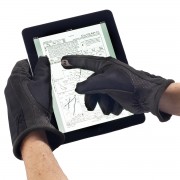Touch Screen Issues For the Consumer experience
Not too long ago, the CEOs of both equally Samsung and LG instructed audiences at Cellular Planet Congress in Barcelona that their providers would only sell contact screen cell telephones soon after 2012. The variety two and a few mobile handset OEMs [in terms of volume] believe that contact monitor phones will be a lot less high-priced to manufacture [critical pads and the dome sheets cost about USD $one-2, they dress in-out, and they crank out ~twenty% of the RMAs] in the close to long term. And still, I imagine we can all concur, black or white monoliths with virtual “buttons” are not the finest person experience on a mobile cellular phone.
There are two important sorts of touch screens: Resistive and Capacitive. Both of those have strengths and the two have weaknesses. [From Wikipedia] “A resistive contact screen panel is composed of numerous layers. The most important are two slim metallic electrically conductive and resistive layers divided by skinny area. When some item touches this sort of contact panel, the layers are linked at a sure position the panel then electrically acts identical to two voltage dividers with connected outputs. This brings about a adjust in the electrical present-day which is registered as a contact function and despatched to the controller for processing.
“Resistive touch screen panels are normally the most affordable technologies but supply only 75% clarity (premium movies and glass finishes allow for transmissivity to technique eighty five%) and the layer can be completely harmed by sharp/tough objects [ed. like keys in your pocket]. Resistive contact monitor panels are not affected by outdoors things this sort of as dust or h2o and are the variety most usually utilized right now.” In most resistive contact screens, when the implementation is superior – the user practical experience is ample. When the resistive contact display screen is average [or underneath], the UX is tricky [with screens maddeningly necessitating greater or lesser tension than is intuitive].
A capacitive “touch screen panel is coated with a content, typically indium tin oxide [ITO], that conducts a ongoing electrical current throughout the sensor. The sensor as a result exhibits a exactly managed subject of saved electrons in both equally the horizontal and vertical axes – it achieves capacitance. The human entire body is also an electrical product which has stored electrons and thus also displays capacitance. Capacitive sensors do the job centered on proximity, and do not have to be right touched to be activated. It is a sturdy technology that is utilised in a wide vary of applications such as place-of-sale programs, industrial controls, and public information kiosks. It has a increased clarity than Resistive technological know-how, but it only responds to finger get in touch with and will not work with a gloved hand or pen stylus. Capacitive touch screens can also help Multitouch.” [Also from Wikipedia] Capacitive contact screens are comparatively much more expensive and have issues in humid and rainy environments. And in my not-so-humble view, the quantity of untrue-good responses that can be created on a capacitive screen is extremely tough to the UX.
So both equally of the well-known sorts of touch screens have issues to the UX. But incorporating haptics or tactile responses to a touch screen enhances significantly the over-all UX. Investigate from the College of Glasgow Scotland [Brewster, Chohan, and Brown 2007] implies that consumers cut down problems (twenty%), increase enter velocity (twenty%), and lower their cognitive load (forty%) when contact screens are combined with haptics, [vs. non-haptic touch screens]. The exact team is now analyzing the combination of visual, auditory and contact comments and the permutations therein. Success are predicted later on this calendar year.
LG and Samsung both equally use haptics when deploying contact display screen telephones and have sent above 30M such gadgets in 2008. Nokia has accredited and deployed [and will continue on to deploy] haptics.
Options exist for ATMs/kiosks, PNDs, PMPs, automotive, gaming and other equipment to deploy haptics and therefore greatly enhance the in general UX. What other units could profit from haptics?



Leave a Reply
Want to join the discussion?Feel free to contribute!